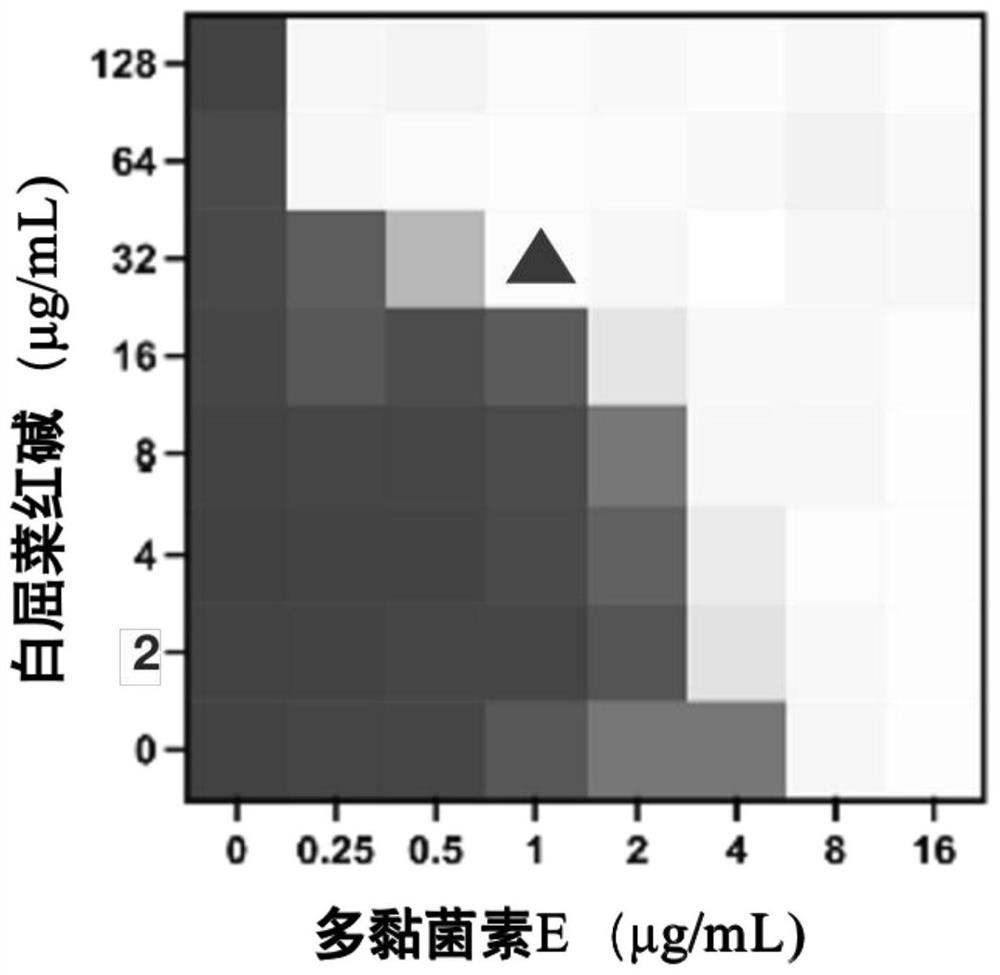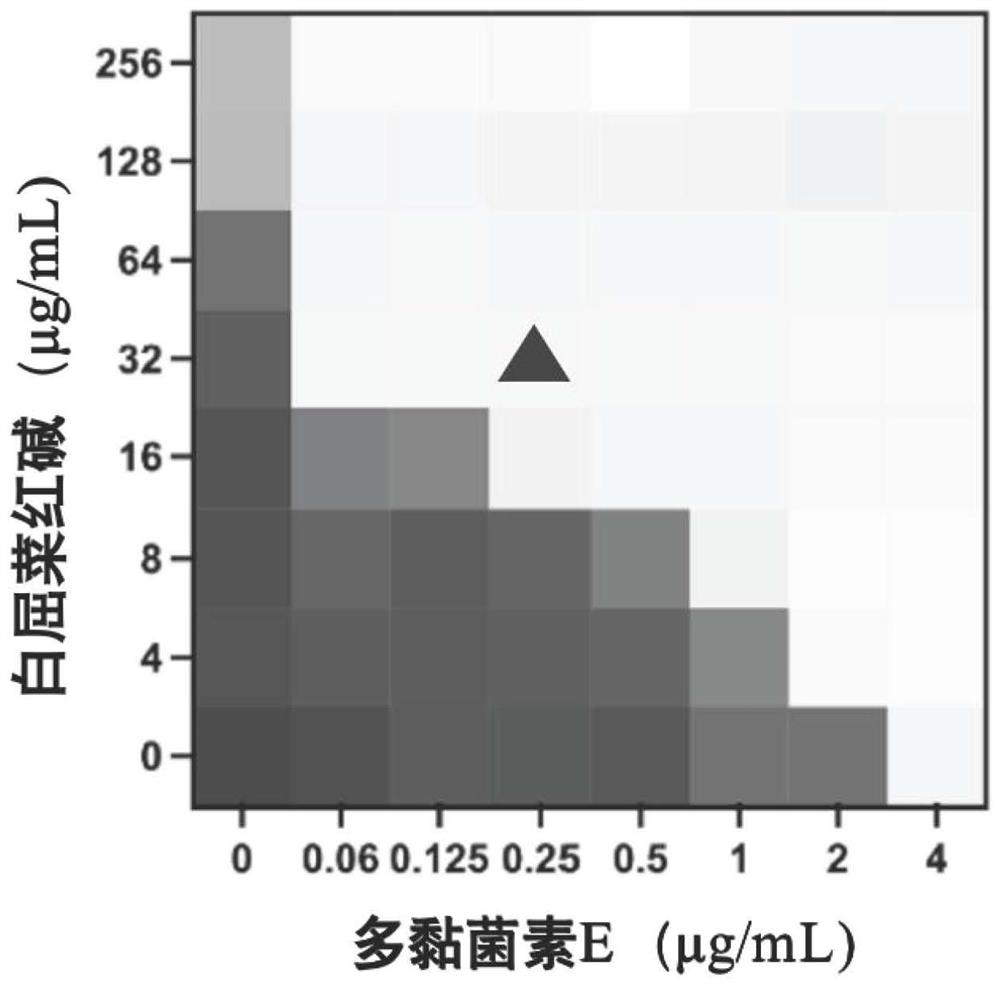Application of combination of chelerythrine and polymyxin E in inhibition of polymyxin E drug-resistant bacteria
A technology of chelerythrine and polymyxin, applied in the field of biomedicine, can solve the problem that chelerythrine inhibits mcr-positive bacteria and other problems
- Summary
- Abstract
- Description
- Claims
- Application Information
AI Technical Summary
Problems solved by technology
Method used
Image
Examples
preparation example Construction
[0027] The preparation method of the culture medium involved in the following examples is as follows:
[0028] MH liquid culture medium: add 25 g of MH broth medium (Beijing Luqiao Technology Co., Ltd.) to an appropriate amount of distilled water, then dilute to 500 mL with distilled water, sterilize by autoclaving at 121° C. for 20 min, and cool.
[0029] mcr-1 positive Escherichia coli ZJ807 is described in the following literature: Y Wang, GB Tian, R Zhang, Y Shen, JM Tyrrell, X Huang, H Zhou, L Lei, HY Li, Y Doi. Supplementary material: Prevalence, risk factors , outcomes, and molecular epidemiology of mcr-1-positive Enterobacteriaceae in patients and healthy adults from China: anepidemiological and clinical study. The Lancet Infectious Diseases. 2017. The genome sequence of mcr-1-positive Escherichia coli ZJ807 has been uploaded to NCBI, BioSample Accession Number : SAMN05437814. mcr-1 positive Escherichia coli ZJ807 is a polymyxin E-resistant bacteria.
[0030] mcr-8...
Embodiment 1
[0032] Embodiment 1, adopt the checkerboard method to detect the minimum inhibitory concentration of chelerythrine combined with polymyxin E to polymyxin E-resistant bacteria
[0033] According to the CLSI M27-A3 drug susceptibility test standard, the checkerboard method was used to detect the effect of chelerythrine alone, polymyxin E alone and "chelerythrine and polymyxin E combined" on polymyxin E Antibacterial activity of drug-resistant bacteria (mcr-1-positive Escherichia coli ZJ807, mcr-8-positive Klebsiella pneumoniae KP91, or mcr-9-positive Salmonella SLM183), thereby obtaining minimal antibacterial activity against polymyxin E-resistant bacteria concentration. Specific steps are as follows:
[0034] 1. Take the polymyxin E-resistant bacteria liquid that has grown to the logarithmic growth phase, first adjust it to McFarland 0.5 with a McFarland turbidimeter, and then dilute it with MH broth medium 100 times to obtain polymyxins E-resistant bacteria dilution. In the...
Embodiment 2
[0050] Example 2. Time-kill curve of chelerythrine combined with polymyxin E against polymyxin E-resistant bacteria
[0051] Polymyxin E-resistant bacteria were mcr-1 positive Escherichia coli ZJ807, mcr-8 positive Klebsiella pneumoniae KP91 or mcr-9 positive Salmonella SLM183.
[0052] 1. Take the polymyxin E-resistant bacteria solution that has grown to the logarithmic growth phase, and adjust it to McFarland 0.5 with a McFarland turbidimeter to obtain a polymyxin E-resistant bacteria dilution. In the dilution of colistin-E-resistant bacteria, the concentration of colistin-E-resistant bacteria is about 1 × 10 6 CFU / mL.
[0053] 2. Take 12 test tubes, add 2970 μL MH liquid medium and 30 μL polymyxin E-resistant bacteria dilution to each, and mix well; then 12 test tubes are randomly divided into chelerythrine group, polymyxin group Group E, the combined group and the blank group of 4 groups, each with 3 test tubes, were treated as follows:
[0054] The chelerythrine group:...
PUM
 Login to View More
Login to View More Abstract
Description
Claims
Application Information
 Login to View More
Login to View More - R&D
- Intellectual Property
- Life Sciences
- Materials
- Tech Scout
- Unparalleled Data Quality
- Higher Quality Content
- 60% Fewer Hallucinations
Browse by: Latest US Patents, China's latest patents, Technical Efficacy Thesaurus, Application Domain, Technology Topic, Popular Technical Reports.
© 2025 PatSnap. All rights reserved.Legal|Privacy policy|Modern Slavery Act Transparency Statement|Sitemap|About US| Contact US: help@patsnap.com



